Derivative of sine, geometric proof
Categories: differentiation calculus

The first derivative of the sine function is the cosine function:
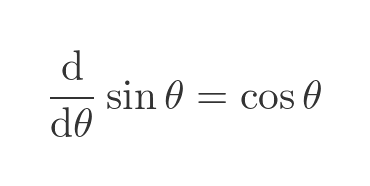
In this article, we will provide a simple geometric proof of this result.
Sine in a unit circle
This diagram shows part of a unit circle, centred at O:

The right-angled triangle OPA has an angle θ at the centre of the circle. We can find the sine of the angle from the standard formula:
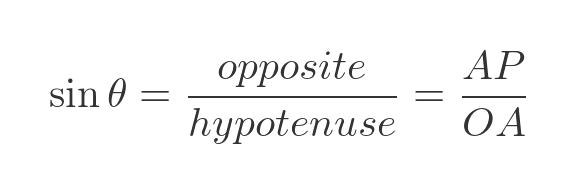
We will represent the length AP as y. Since OA is the radius of a unit circle, it is 1. So the sine of θ is simply:
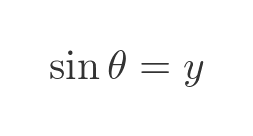
While we are looking at this diagram, it is also worth noting that the arc of the circle between X and A has a length θ. That is because the arc subtends an angle θ at the centre of the circle. The length of an arc is given by rθ (provided θ is measured in radians), and since r is 1 for a unit circle, the length is simply θ. We will use this result later.
Incrementing θ
Here is what happens when we increase θ by a small amount Δθ:
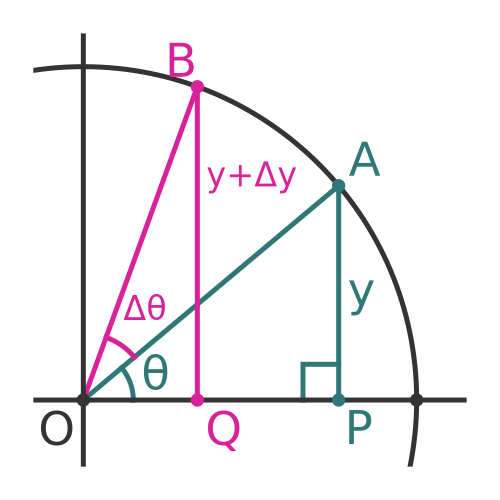
If we draw a radius with an angle of θ + Δθ, it meets the circumference as point B.
We previously noted that AP, the perpendicular height of A from the x-axis, is equal to the sine of θ. We called the distance y:

The perpendicular height of B from the x-axis is BQ. Let's call this new distance y + Δy. This is equal to the sine of θ + Δθ:

We can now write a difference formula for the change in sine θ, as θ changes:
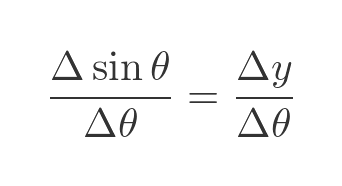
The limit as Δθ tends to zero gives us the derivative of the sine function:

If we can find an expression for Δy as a function of θ, we should be able to solve this equation to find the derivative of the sine function.
Finding Δy
We will now add an extra point C to create a triangle ABC. We will place C vertically above point A and horizontally in line with point B:

Some observations about the triangle ABC:
- Since AC is vertical and BC is horizontal, angle C must be a right angle.
- Since A is a distance y from the x-axis, and B is a distance y + Δy from the x-axis, side AC has length Δy.
- The arc length AB has length Δθ for reasons we discussed earlier.
Triangle ABC as Δθ tends to zero
As Δθ tends to zero, the arc AB tends towards a straight line, and furthermore, that straight line is a tangent to the circle:

In the limit as AB tends towards a straight line, the length of the line AB tends towards the length of the arc AB, which is Δθ.
Also, since a tangent and a radius of a circle meet at 90 degrees, the angle OAB tends towards a right angle.
It is easy to verify through simple geometry that, when OAB is a right angle, the angle BAC is equal to the angle AOP, which is θ.
Finding the derivative of sine
Here is the triangle ABC, and everything we know about it:

This represents the triangle as Δθ tends to zero. From the triangle, basic trigonometry tells us that:
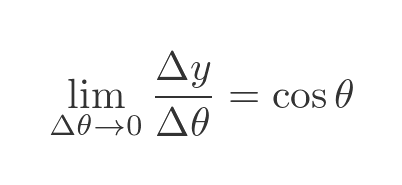
We know from earlier that:

This proves that:

See also
- Slope of a curve
- Differentiation from first principles - a to the power x
- Differentiation from first principles - x²
- Second derivative and sketching curves
- Differentiation - the product rule
- Differentiation - the quotient rule
- Differentiation - the chain rule
- Differentiation - derivative of an inverse function
- Differentiation - L'Hôpital's rule

Join the GraphicMaths Newletter
Sign up using this form to receive an email when new content is added:
Popular tags
adder adjacency matrix alu and gate angle answers area argand diagram binary maths cartesian equation chain rule chord circle cofactor combinations complex modulus complex polygon complex power complex root cosh cosine cosine rule countable cpu cube decagon demorgans law derivative determinant diagonal directrix dodecagon eigenvalue eigenvector ellipse equilateral triangle euler eulers formula exercises exponent exponential exterior angle first principles flip-flop focus gabriels horn gradient graph hendecagon heptagon hexagon horizontal hyperbola hyperbolic function hyperbolic functions infinity integration by parts integration by substitution interior angle inverse hyperbolic function inverse matrix irrational irregular polygon isosceles trapezium isosceles triangle kite koch curve l system line integral locus logarithm maclaurin series major axis matrix matrix algebra mean minor axis n choose r nand gate net newton raphson method nonagon nor gate normal normal distribution not gate octagon or gate parabola parallelogram parametric equation pentagon perimeter permutations polar coordinates polynomial power probability probability distribution product rule proof pythagoras proof quadrilateral questions radians radius rectangle regular polygon rhombus root sech segment set set-reset flip-flop sine sine rule sinh sloping lines solving equations solving triangles square square root standard curves standard deviation star polygon statistics straight line graphs surface of revolution symmetry tangent tanh transformation transformations trapezium triangle turtle graphics uncountable variance vertical volume volume of revolution xnor gate xor gate